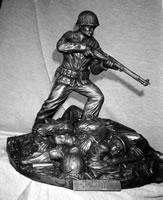
General Day and Marines

Statue dedicated to General James L. Day
Home | Site Map | Photos | Contacts | Continue =>

General Day and Marines |

Statue dedicated to General James L. Day |
THE MARINES DEPARTED THE SHIP ON Easter morning, April 1, 1945, as planned, including Lt. Col. Horatio Woodhouse, Cpl. James Day, and Pfc. Dale Bertoli—who were all destined to become war heroes. By dawn of May 14th, the Marines of the 2nd Battalion, 22nd regiment had been pinned down for 30 hours. Cpl. James Day with his platoon was ordered to try to take and hold the western slope of Sugar Loaf Hill. If the hill could be secured, the enemy’s cross fire would be disrupted, allowing the Americans to break through.
Day—a survivor of Eniwetok and Guam—and his crew fought their way up the hill in the face of heavy artillery fire, and dropped into a 30-foot crater. They were immediately attacked by Japanese soldiers. When they rose to defend themselves, they were hit by bullets and shrapnel. Day felt searing metal across his arms. He jammed fresh clips into his rifle and threw hand grenades so they would bounce down the hill. The attack was beaten back.
Of the eight men who had made it with him to the crater, three were dead and three were wounded. Minutes later, the Japanese launched a second attack. Day shot three who had made their way into the crater.
Night came and the Japanese soldiers tried making their way up the hill. When Day heard them coming up the hill, he threw hand grenades at the shadows. At daylight, the hill was pounded with mortar fire. The enemy moved up the slope, but Day rose and turned back the attack. Late in the afternoon of May 15, another attack began. Day and McDonald fired bursts down the slope when an anti-tank gun fired. McDonald was killed instantly and shrapnel riddled Day’s hands. Day dragged a machine gun to the lip of the crater and fired until the attackers retreated. At dawn, May 16, Day heard the scrape of boots. The enemy soldiers were only 40 feet away. He cut several down and drove the rest off. At nightfall, Day fought to stay awake, continued to fire at the enemy, taking out two machine gun nests.
The next day the Marines arrived and relieved Day and Bertoli, who had struggled down the slope through the advancing column. Defending Sugar Loaf Hill for three days and nights would prove to be the key to smashing the enemy’s line across Okinawa. Lt. Col. Horatio Woodhouse, Day’s battalion commander, set the wheels in motion to recommend Day for the Congressional Medal of Honor. Woodhouse and Bertoli were killed in battle and Day was badly wounded. His Medal of Honor never moved up the chain of command.
Mark Stebbens, nephew to Day’s deceased company commander, later located a box with all the necessary records and forwarded them to Day.
On January 20, 1998, Maj. Gen. James Day (Ret.) stood in the East Room of the White House and received the Medal of Honor.
Readers Digest, December 1998